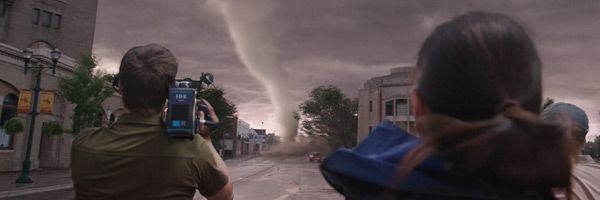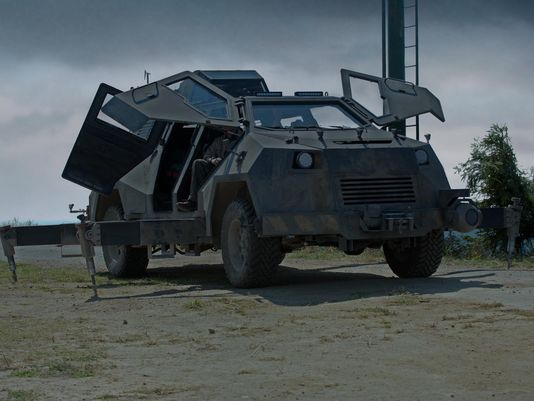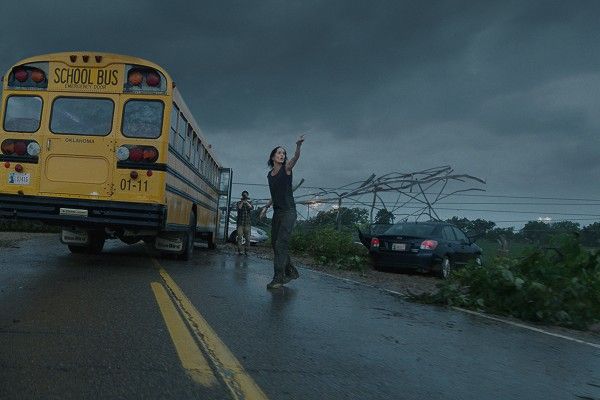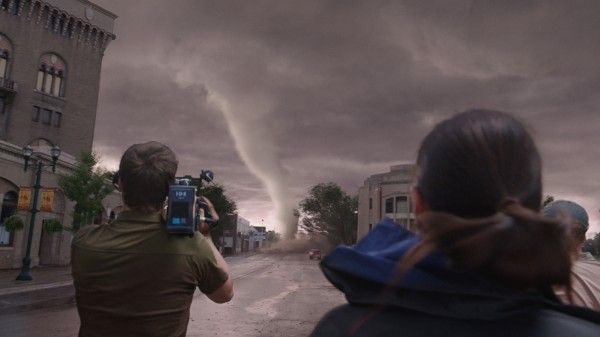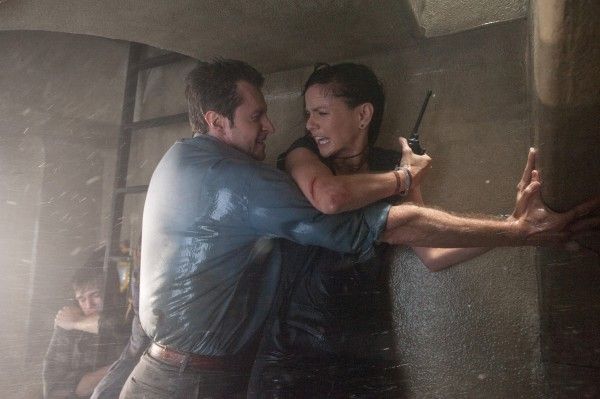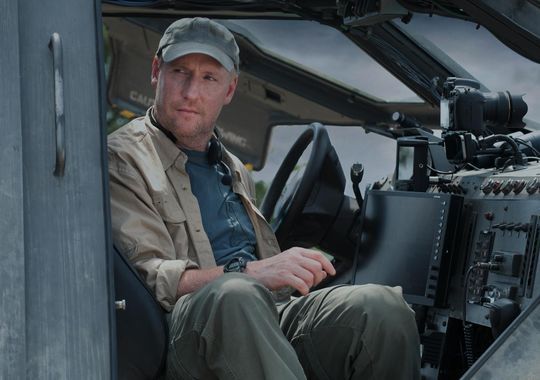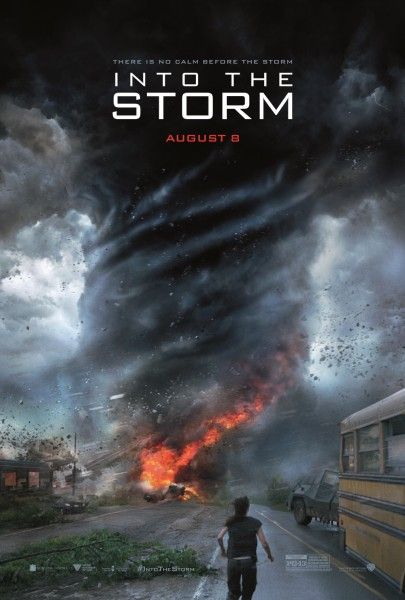While on the Detroit set of Steven Quale's tornado picture Into the Storm, our select group of visiting journalists got a chance to sit down with producer Todd Garner to talk about the natural disaster film. Knowing the movie would get the inevitable comparisons to the 1996 picture Twister, Garner commented on this film's found footage take on the weather phenomenon, the use of multiple cameras in different shooting styles to add a new dimension, as well as the teams visual effects experience that helped bring the tornadoes to life.
Starring Richard Armitage, Sarah Wayne Callies, Matt Walsh, Alycia Debnam-Carey, Arlen Escarpeta, Max Deacon, Nathan Kress, Jeremy Sumpter, Kyle Davis, and Jon Reep, Into the Storm opens August 8th. Be sure to check out the film's recently released trailer here. Hit the jump for our set visit interview with Garner. Spoilers follow.
Question: Can you tell us the concept of the film?
Todd Garner: The concept is the worst tornado storm ever to hit the United States and it’s told from the point of view of the people that were trapped in the middle of it. So in essence it’s a found footage movie kind of thing. But it’s told from the perspective of a father looking for his son, a young couple that sort of migrated off away from their friends to film something for a school project of hers, students at the school because they all have cameras, a storm hunting unit which has storm trackers and a chase van and then these two dipshits that are trying to be storm hunters that think they know where they’re doing with their GoPro cameras and are kind of YouTube guys. So it’s about all of those people being in the middle of this extraordinary situation and how all those stories ultimately come together. So the idea would be like someone has pieced together all of these stories. Because what was important to me when I came up with the idea was having lived in Los Angeles and been through a bunch of earthquakes, how do ordinary people react to extraordinary situations. That’s what totally fascinates me. Like if you look at Katrina or Joplin or the tsunami in Japan it’s all documented now. It’s insane how much you can get on all this stuff. But secondly, one minute you’re a fisherman in Japan the next minute you’re five miles out to sea. What does that do to your life? And how do different people react? That’s sort of the impetus.
How did you get Simon Beaufoy involved?
Garner: Well, he’s been a friend of mine forever. I tried to actually buy…when I was at Disney I tried to buy Full Monty. I read it and thought it was a sample and called Simon and said I want to buy this. And he goes, "It’s being made." In the back of my head I’m like all right when it comes out and makes a dollar I’ll remake it. And then there was Full Monty. And then we became friends and he wrote a lot of different projects for me over the years most of which didn’t get made. So I called him and said, "Would you mind doing me a favor?" and he did me a favor. He did 127 Hours and has a really kind of cool understanding of the way real people talk with internal feelings and he said yes. So it was cool, I just caught him at the right time between projects.
Since there are different things recording the movie, is there a different look?
Garner: You’d have to ask Steve that but yes I would imagine there would be. I mean we’re using basically every kind of camera I’ve ever seen on a movie set from flip phones to GoPros to these cool Nikon cameras to REDs to every format. So I would imagine it’s going to look different. And the way he’s shooting each piece of it, again he can speak to more of this than me, because the storm trackers have a different way of shooting than the two dipshits with GoPros. It’s not like Cloverfield with one camera filming the whole thing; it’s many, many, many different cameras. So all of the different characters in the movie have a different shooting style. And in terms of treating the film, I don’t know.
How much action versus special effects?
Garner: We don’t have a real tornado. When I first came up with the idea for this movie I was like we can shoot this in three hours! Wait for a real tornado, give the actors some cameras and have at it. It didn’t turn out that way as you can see with all the cranes and everything. It’s got a lot of action and a lot of special effects. There’s no real tornadoes so it’s all going to be digital. Which is why I always wanted Steve to direct this movie, even when it was just a spec. I hired Swetnam to write the spec and I was going to take it out as a package and I wanted Steve because I’d seen Final Destination and I had been intrigued by his special effects training and also his second unit training with Jim Cameron and so I was going to attach him and then John Swetnam’s manager got nervous because he’d heard there was another found footage tornado movie out there. So we went out with it as a spec and New Line bought it and said we’d like to put John Swetnam on it and I was like all right cool because that’s what I was going to do anyway. The effects being such a big part of it led me to him.
Would you say it’s a pure ensemble or is there more of a focus on some characters?
Garner: Well Richard Armitage is number one on the call sheet. So I think that story, at least emotionally, is the biggest story because it’s closest to my own dad so emotionally it's kind of the biggest story in terms of a father just trying desperately to find his son that’s out there. But in terms of screen time I would say it’s probably a pure ensemble. But just in terms of the way the story is laid out that’s probably the biggest emotional arc.
Was there a specific piece of footage from one of the disasters that happened recently that triggered this?
Garner: What triggered it was, I’m fascinated by the found footage idea or the first-person camera footage idea because I think it puts you in the driver’s seat of the movie like I hadn’t seen before. Originally I wanted to do a found footage alien movie and then Battle of LA came out so I was thinking about it and I think the first found footage I ever saw was either this or bigfoot. And I’m not really ready to do my bigfoot movie yet. It’s really the first thing I ever saw. Everybody was fascinated by huge tornadoes. So it kind of came about through that.
How much did the incident in Joplin impact what happened with this movie?
Garner: I came up with the idea in May of 2011 and I think Katrina probably influenced me more than Joplin because it was just…again it’s not so much specifically to tornadoes although they are very cinematic and they happen during the day which is interesting usually but it’s more about how people react. So many stories came out of Katrina about ordinary people doing extraordinary things. Getting boats, getting hundreds of people out, some people just freezing, getting out. If you’ve ever seen a documentary about Katrina some people are just drinking so the Donk and Reevis characters came from guys who were just having a hurricane party, we’re going to drink beers! Some people just do that and some people leave and then when it hits what do you do? How do you react? SO it was really more about that than specifically to tornadoes. And then also being on location I’ve been out in the field as it were since Broken Road was formed six years ago, I’ve seen it. I’ve seen the weather channel. I don’t know if it’s global warming or just patterns of the world historically but something is going on. So I’ve been interested in that, I’ve been interested in the study of that and how these storms are kind of happening more frequently, and the earthquakes and the tsunamis. I’m interested in that in general anyway.
In a film like Final Destination, audiences are rooting for the destruction or the deaths, is that the case in this?
Garner: I hope not. I think you’re rooting for…see the problem with YouTube, and I don’t blame these people, but it generally is a lot of this: Oh my gosh there’s a tornado here it comes, oh shit, run. And it’s usually drop the camera and you’re like, "Ohhh, I almost saw it! It’s like close but not right there." So we have one guy whose obsession is to get into the eye, which is why he created the TITUS. And then everybody else, just because it’s a movie, is able to stay in it and see what is usually happening when people are running away. So the answer to your question is I hope people aren’t rooting for the characters to die like in Final Destination but I do think people will hopefully be intrigued and be able to get all the way up as opposed to…we do have some of that too just implied carnage. Because that’s very scary too when you hear something, when you hear people reacting and you’re not able to see so you feel a little helpless. We have that. But hopefully people will be intrigued to actually hang in there as long as possible to see what happens.
What demographic is this filmed aimed at?
Garner: People. Personally, I don’t know, I’m sure you’re very impressed by my credits. I personally make movies for everybody. I try to make movies that everybody from my kids to everybody can see and enjoy because I feel like for me movies are a communal experience so I try to make movies that a lot of people can enjoy together.
Could you talk more about TITUS and the storm chasers? Are they scientific or adrenaline chasers?
Garner: I don’t think those things are ever pulled apart when it comes to storm chasers. They’re both. And the guys that we’ve talked to they’re like astronauts because those guys are not your typical scientist guys. Those guys like to be explorers. So the reason why we cast Matt in this role was to get away from that. To not have it be just pure adrenaline junkie guy but to have a guy who’s a little bit at the end of his rope, little bit at the end of the line and this is kind of it for him because this is hard work. Storm chasing is expensive and it’s very very hard to get it. Because it’s not like the moon where you know where it is and can go there. These things pop up all over and you can only drive there. You can’t really bring a helicopter into one. So it’s a lot of long lenses and if you saw Tornado Alley, it’s a lot of long lenses and showing up at the end just after one left. So he’s had that experience in his life of trying to do it on his own and finally now in this instance where the guy is pulling his funding. His last resort, the guy who backed this, was to throw in some scientists to maybe give him an edge. And even she’s like they’re tornadoes not buildings that we can just go drive up to. So he wants that shot. He wants to get inside of it for the shot and she if definitely about why is this happening so much now? Is it global warming? Is it just natural occurrences? And if we don’t understand it, could it happen in LA? Could it happen in New York? Will we be ready? So it’s more complicated than just one or the other.
How scientific does it get?
Garner: I mean it’s weather and it’s accurate. So it’s a lot of doplars and guessing where it’s going to land so it’s accurate but it’s not overly scientific.
Is there a good amount of comedy in the movie?
Garner: Yeah. I mean Matt is not playing a strictly comedic character as much as a guy who’s just more rye and sardonic. And more self aware of the fact that this is it. It’s like come on if I don’t get this what am I going to do? There’s not a lot of work for out of work old storm chasers. SO he’s very aware. Donk and Reevis are pure insanity. Those are the guys you see on Jackass. Donk and Reevis, if Johnny Knoxville and Rob Dyrdek were chasing tornadoes this is what they would be doing. And I know those guys are out there. So they are funny. Because their point of view is if I just put plywood on my truck I’ll be fine. So that actually doesn’t turn out that well for them. So yes. It wasn’t intentionally designed that way it just was born out of these characters.
It seems like found footage movies have traditionally been in the horror genre how do you think this moves that type of movie outside of that?
Garner: Well no I mean Cloverfield and Chronicle both, I think, did a good job of moving it outside. And I would even say Battle: LA in a certain way had that vibe of being a found footage movie. I don’t feel like I’m moving the needle. It’s not like I’m like yeah I'm movie the needle out of the horror genre. No I think it worked so well in the horror genre because it’s emotionally rooted in things that you see every day and can happen to you. And I think that’s why specifically Cloverfield and Battle of LA and this are in the same genre because it’s an extraordinary thing happening in a personal space. It’s not like a found footage movie going to the moon, which there was one of those. This is happening in your hometown. Cloverfield, Battle: LA and now this. So for me it’s more of an experiential thing than a genre thing.
Is there anything you dislike about found footage that you’re trying to avoid?
Garner: Personally no. I know that the knock on found footage movies has been the shaky cam but I’ve worked with directors who’ve shot worse shaky cam that’s not found footage. It doesn’t bother me if it’s done right. But I know that’s the knock on it. It’s too disorienting. So that’s a good question for Steven because I know that bothers him. So he’s been very specific about giving you the feeling and experience of being first person but the fact that we do have real cameramen who can actually get a good shot. He’s really being careful about making sure it’s a good shot but also not making it feel like it’s just so big cranes.
Can you talk about the framework of the film? Someone is editing these together?
Garner: The framework of the movie is that this is the worst storm to ever hit the United States and is book ended by a CNN news report. The idea is that they’re telling the complete story in the way that Tornado Alley or the documentary about Joplin did that. It’s the same idea.
What do you think is the attraction for storm chasers?
Garner: I think it’s so attractive because it’s tough to imagine going to the moon. It’s tough to imagine going to the bottom of the ocean. You can’t really explore new lands anymore because where are you going to go? Pretty much everything has been done. So this is something that you can do. An ordinary person can do it in theory. So there’s a spirit of adventure to it. And there’s the spirit of it being extremely dangerous and exciting. And also because I don’t think anybody does it without wanting to understand it. There’s also this feeling of being able to kind of control it. Ultimately by either improving the warning systems, understanding if they are getting worse. What is the ideal situation on why tornadoes are occurring which is why Tornado Alley is so vulnerable is the hot meeting the cold air. So I think that all of those things combined make it like the closest thing right now to Lewis and Clark. It’s like finding new pieces of pieces of it in the real world.
Other than father and son, what sort of emotional arcs do you have?
Garner: Without getting specific, the overriding emotional arcs are how each individual deals with their own fear in a time of extreme stress. So like what do you do? What kind of person are you ultimately in that situation? So all of the overriding emotional arcs for all of the characters deal in that specifically.
Did you do any storm chasing?
Garner: No. It’s so hard. It would be a lot of driving around on dirt roads. I mean it’s so hard.
Be sure to check out our set visit interviews from Into the Storm with the following cast and crew:
- INTO THE STORM: 35 Things to Know about Steven Quale's Natural Disaster Film Starring Richard Armitage and Sarah Wayne Callies
- Director Steven Quale Talks INTO THE STORM, the Film's Timeframe, Shooting from Multiple Perspectives, Interlinking Stories & His Special Effects Background
- Richard Armitage Talks INTO THE STORM, How the Story Incorporates Found Footage, Character Interaction, Wire/Waterwork & Practical Effects
- Sarah Wayne Callies Talks INTO THE STORM, Insight into Her Character, Intimacy of Trust, Green Screen vs Theater, Wirework Stunts, and Tornado Chasing

